
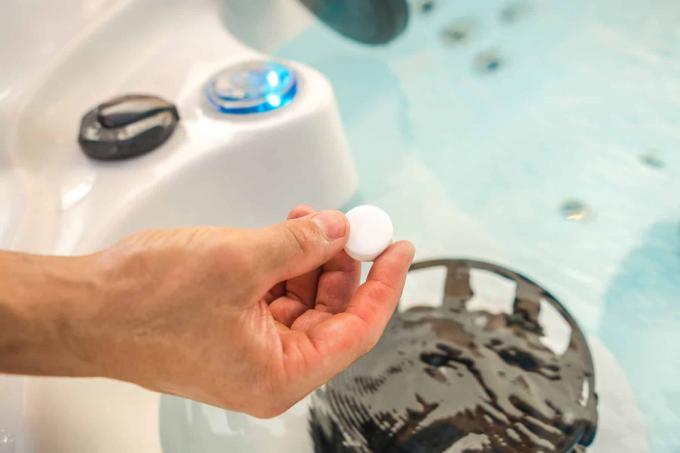
Table of contents
- definition
- application reasons
- Preparation
- time
- Middle
- Perform shock chlorination
- dosage
- Length of time
- Repetition
- dangers and problems
- Frequently Asked Question
If the pool water is milky or even green, shock chlorination can help. This guide to shock chlorination shows how to proceed, what dangers exist and what else needs to be taken into account.
definition
With shock chlorination, a larger amount of chlorine is added to the water to kill germs and algae, thereby clearing it again.
Chlorine is part of general and basic pool maintenance, but under certain circumstances the recommended dosage may not be sufficient. Shock chlorination is then a way of making the pool usable again safely with little effort and without wasting water.
application reasons
Shock chlorination may be necessary for a variety of reasons. These include, among others:
- intensive use of the pool
- very high temperatures
- strong sunlight
- insufficient filter performance
- Increased dirt entry due to unfavorable location, storm or thunderstorm
- dirt in the filter
- too low chlorine content

Shock chlorination is therefore often necessary in midsummer, when heat, constant use of the pool and contamination brought in by wind or thunderstorms come together.
Preparation
Before the shock chlorination is carried out, a corresponding preparation must be carried out. This includes the following points:
- clean filter
- replace cartridges if necessary
- remove coarse dirt with a net
- Clean pool walls and floor
As a result, a better effectiveness of the chlorine is already achieved.
time
The desired effect of chlorine decreases with UV radiation. The shock chlorination should therefore be carried out in the evening. Alternatively, overcast days can be chosen or the pool can be covered.
A notice:
In the case of a pool filter with a UV element, this must first be switched off.
Middle
Various means can be used for shock chlorination of the pool when the water is green. It is important that the products are approved for pool water care.
On the market you can find:
- chlorine granules
- chlorine tablets
- liquid chlorine
Chlorine granulate has the advantage that it has a high concentration, can be dosed exactly and dissolves quickly.

Just like chlorine in the form of tablets, it is practical to use and saves space. However, unlike liquid chlorine, it must be dissolved beforehand, so it requires some preparation.
Perform shock chlorination
When the preliminary cleaning of the pool and pump is complete, the actual shock chlorination takes place. The following steps are necessary for this:
- Calculate the amount of chlorine needed.
- Dissolve granular chlorine or crush chlorine tablets and dissolve in water.
- Pour the solution into the skimmer.
- Run the pump continuously.
Tip:
An even distribution of the chlorine is crucial for the desired effect. If the performance of the filter alone is not sufficient, the chlorine can be dissolved or added directly to the water in liquid form and spread with a net. It is important to mix the water with circular movements for several minutes.
dosage
When dosing the respective agent, the concentration is decisive. The information provided by the manufacturer is decisive here. As a rule, 20 grams of chlorine per cubic meter should be used for effective and radical shock chlorination 1,000 liters of water come.
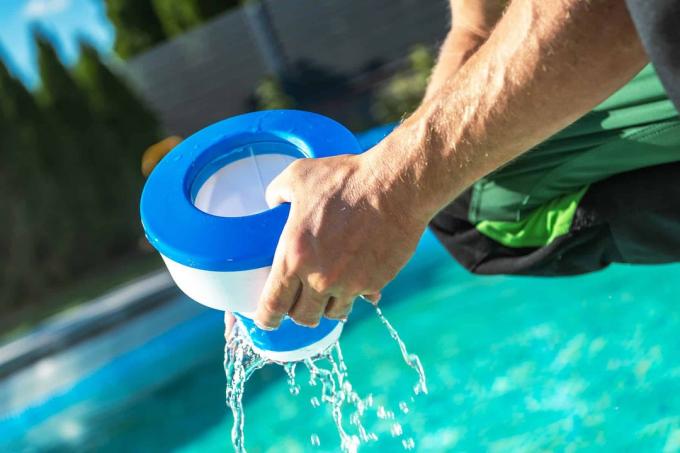
However, the products can differ significantly in terms of composition, so that the manufacturer's information must be taken into account.
In addition, water analyzes can help to achieve the correct chlorine value in the water and, if necessary, carry out additional doses.
Length of time
The high level of chlorine in the water must gradually dissipate. This process can be accelerated by sunlight. High temperatures also favor degradation.
There is no general statement about the exact duration of shock chlorination. It usually lasts 24 to 72 hours.
During these one to three days it is crucial to clean the filter several times. Because germs and algae killed by the chlorine are deposited as impurities in the individual components of the filter.
Repetition
In difficult cases, shock chlorination alone is not enough to completely clear the water.
This is due to various reasons. This includes:
- high temperatures
- strong sunlight
- improper pH
- insufficient distribution
- too low dosage
Ideally, the water has a pH of 7.2 and a temperature of 18 to 20 degrees Celsius. Chlorine then works particularly quickly and efficiently. However, this is not possible in midsummer and when there is heavy pollution.
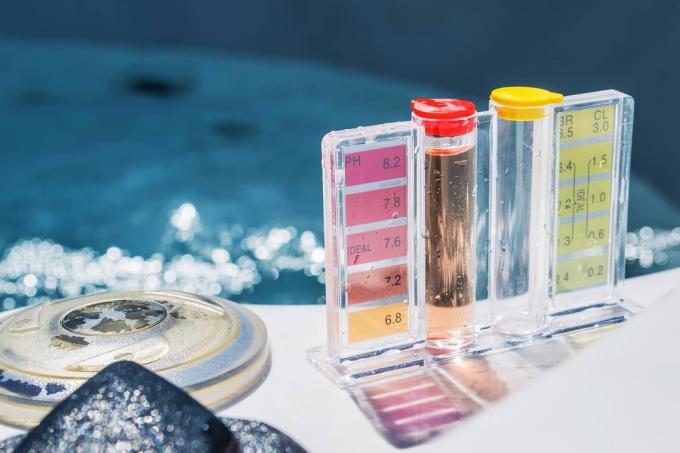
Accordingly, it may be necessary to repeat the shock chlorination. However, if this is necessary every month, the basic care of the pool should be reconsidered.
dangers and problems
After shock chlorination, the pool is initially unusable until the chlorine drops to a safe level. This, in turn, can be determined by analyzing the water.
Careless and unsafe handling of chlorine or water with a high chlorine content can result in the following: difficulties come up:
- strain on the airways
- skin rashes
- Irritations of the skin and mucous membranes
- irritation of the eyes
- acid burns
On the one hand, it is important not to have direct contact with the chlorine preparation when using it. Gloves and, if necessary, goggles when filling should be part of the equipment. On the other hand, the pool must not be used immediately after the shock chlorination.

Another factor that is often not considered is the protection of the pool for the environment and wildlife. The pool must therefore be secured accordingly.
Frequently Asked Question
If shock chlorination alone is not sufficient, a flocculant can also be applied. However, this measure only makes sense 18 hours after the chlorine has spread. Otherwise, the water quality can drop massively. In addition, the filter has to be cleaned several times during this time.
The ideal pH is 7.2. If this is not the case prior to the measure, an adjustment should be made. Otherwise the effect of the shock chlorination is considerably reduced.
The ideal temperature range is between 15 and 18 °C. Even with unheated pools, this is not always the case in midsummer. Appropriate general and consistent basic care and cleaning is all the more important.
 Home editorial office
Home editorial office
Learn more about water in the garden

How quickly does chlorine break down?
How quickly chlorine breaks down in pool water is important information for a number of reasons. It is important to know which factors play a decisive role in the degradation rate. This guide shows which influences are decisive.
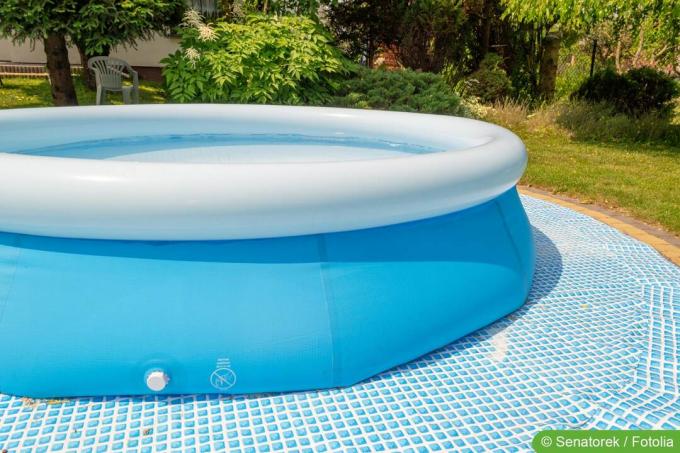
Too much chlorine in the pool: what to do?
If too much chlorine accidentally ends up in the pool or the chlorine value is inexplicably high, there are several measures you can take. This guide shows what can quickly and sustainably help and reduce the chlorine content.

Too much chlorine in the pool: swim anyway?
If too much chlorine has ended up in the pool, the question immediately arises as to whether bathing is still possible. What risks can this entail and what are the warning signs? Here are the answers.

Reducing chlorine levels in the pool: chlorine levels explained
Is the chlorine level in the pool too high and bathing is not possible? Then good advice does not have to be expensive, because the chlorine values can be easily reduced in several ways and thus brought into the optimal range.
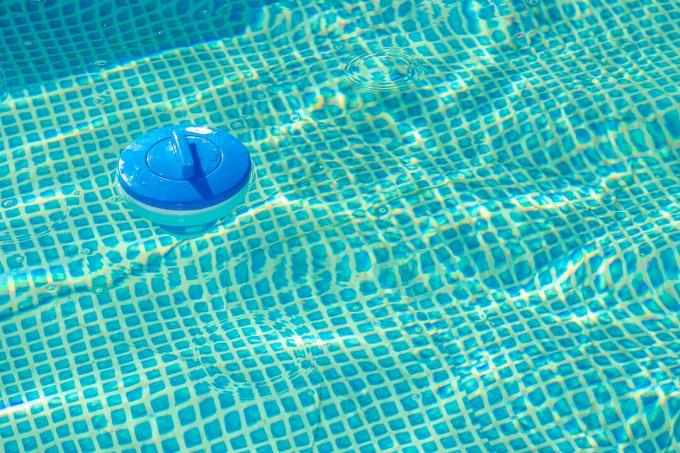
Pool initial filling: initial chlorination dosage
When the pool is about to be filled for the first time, the question of initial chlorination also arises. When and how is it carried out and what dosage is correct. This guide shows step by step how to do it.

How much chlorine in 1,000 liters of water?
Chlorine can keep pool water clear or, as shock chlorination, remove cloudiness and green discoloration. The question of how the right dosage and the optimal values look like arises again and again. This guide provides comprehensive answers.


